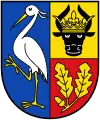Ludwigslust-Parchim
Ludwigslust-Parchim is a district in the west of Mecklenburg-Vorpommern, Germany. It is bordered by (clockwise starting from the west) the state Schleswig-Holstein, the district Nordwestmecklenburg, the district-free city Schwerin, the districts Rostock and Mecklenburgische Seenplatte and the states Brandenburg and Lower Saxony. The district seat is the town Parchim.[2]
Ludwigslust-Parchim | |
|---|---|
 Coat of arms | |

| |
| Country | Germany |
| State | Mecklenburg-Vorpommern |
| Capital | Parchim |
| Area | |
| • Total | 4,750 km2 (1,830 sq mi) |
| Population (31 December 2019)[1] | |
| • Total | 211,779 |
| • Density | 45/km2 (120/sq mi) |
| Time zone | UTC+01:00 (CET) |
| • Summer (DST) | UTC+02:00 (CEST) |
| Vehicle registration | LUP, HGN, LBZ, LWL, PCH, STB |
| Website | www.kreis-lup.de |
Geographic features
There are a number of lakes within the boundaries of Ludwigslust-Parchim district, including:
History
Ludwigslust-Parchim District was established by merging the former districts of Ludwigslust and Parchim as part of the local government reform of September 2011.[2] The name of the district was decided by referendum on 4 September 2011.[3] The project name for the district was Südwestmecklenburg.
Towns and municipalities
| Amt-free towns |
|---|
| Ämter | |||
|---|---|---|---|
|
|
|
|
| 1 - seat of the Amt; 2 - town | |||
References
- "Statistisches Amt M-V – Bevölkerungsstand der Kreise, Ämter und Gemeinden 2019". Statistisches Amt Mecklenburg-Vorpommern (in German). July 2020.
- "Mecklenburg-Vorpommern government reform". Archived from the original on 4 October 2011. Retrieved 5 September 2011.
- "Referendum results Mittleres Mecklenburg". Retrieved 5 September 2011.